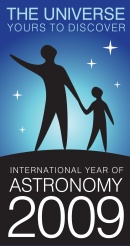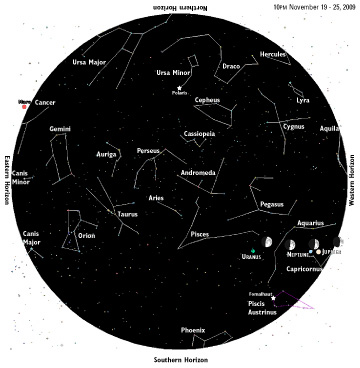Chesapeake Bay's Independent Newspaper ~ Since 1993
1629 Forest Drive, Annapolis, MD 21403 ~ 410-626-9888
Volume XVII, Issue 47 ~ November 19 - November 25, 2009
Home \\ Correspondence \\ from the Editor \\ Submit a Letter \\ Classifieds \\ Contact Us
Dining Guide \\ Home & Garden Guide \\ Archives \\ Distribution Locations \\ Advertising
![]()



Sky Watch

by J. Alex Knoll
From Humble Beginnings
Who knows what may come from a cloud of dust
A nascent crescent moon appears low in the southwest as the sun sets at 5:50 Thursday the 19th. The moon doesn’t linger, sinking beneath the horizon at 8pm. The grouping of stars just trailing the moon is the constellation Sagittarius, the centaur with drawn bow in classical mythology but perhaps more easily recognized today as a teapot, its spout nearest the moon. Friday the waxing crescent appears some 10 degrees higher and now to the left of the teapot’s handle.
By Monday the moon appears high in the south at sunset, paired with the bright yellow glow of Jupiter, less than three degrees below the moon’s lower tip. While you’ll need a telescope or strong field glasses, you might spy the dim light of Neptune forming a triangle three degrees from both moon and Jupiter.
Jupiter aside, there are few bright lights around the moon as it travels through the autumn constellations Sagittarius, Capricorn and Aquarius. The exception, low in the south, is the lonely first-magnitude star Fomalhaut of the constellation Piscis Austrinus, the Southern Fish. The Arabic name Fum al Hut means the fish’s mouth, which drinks from the water carrier Aquarius. In the more temperate climes of the cradle of civilization, this constellation is high overhead and is believed to be the original Pisces of Mesopotamian lore, which only later became the zodiacal constellation we today call Pisces.
Fomalhaut, pronounced fo-ma-low, is the 18th brightest star, 16 times more luminous than our sun. Beyond the realm of sight, however, astronomers have discovered a mass of infrared radiation coming from what they believe to be a cluster of icy dust particles four times larger than our solar system. From such humble beginnings, they speculate, our own planetary system coalesced.
Illustration: © Copyright 1925 M.C. Escher/Cordon Art-Baarn-Holland; Graphics: © Copyright 2009 Pacific Publishers. Reprinted by permission from the Tidelog graphic almanac. Bound copies of the annual Tidelog for Chesapeake Bay are $14.95 ppd. from Pacific Publishers, Box 480, Bolinas, CA 94924. Phone 415-868-2909. Weather affects tides. This information is believed to be reliable but no guarantee of accuracy is made by Bay Weekly or Pacific Publishers. The actual layout of Tidelog differs from that used in Bay Weekly. Tidelog graphics are repositioned to reflect Bay Weekly’s distribution cycle.Tides are based on National Oceanic and Atmospheric Administration and are positioned to coincide with high and low tides of Tidelog.
© COPYRIGHT 2009 by New Bay Enterprises, Inc. All rights reserved.
